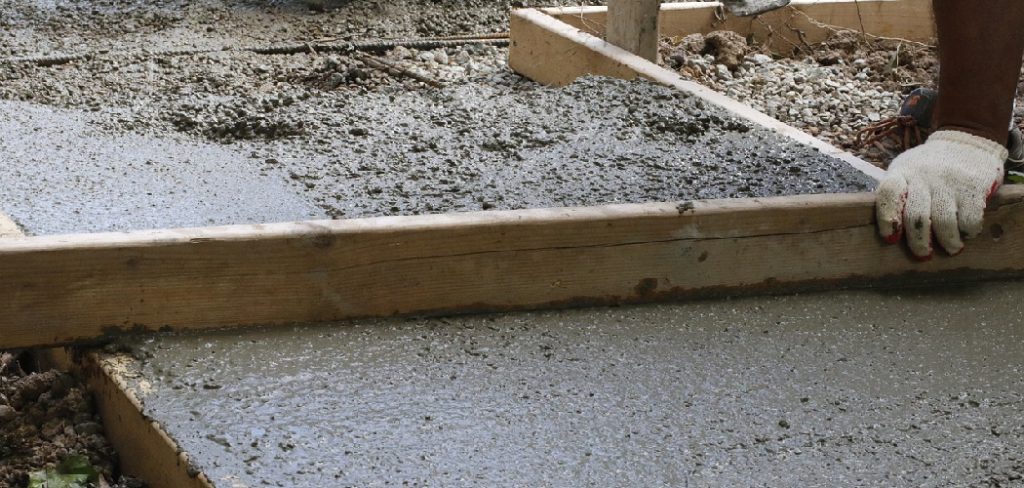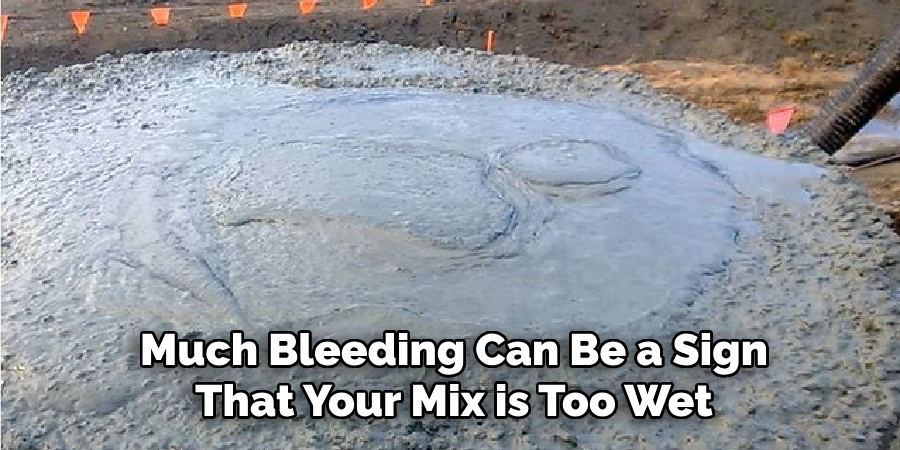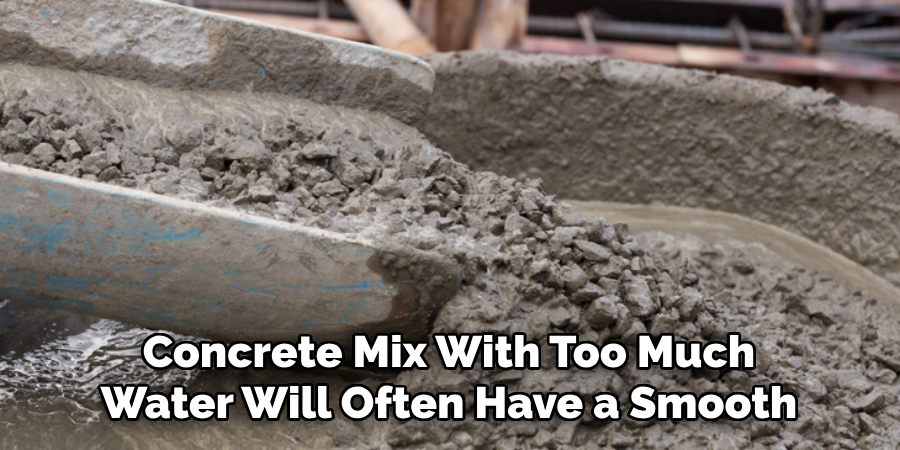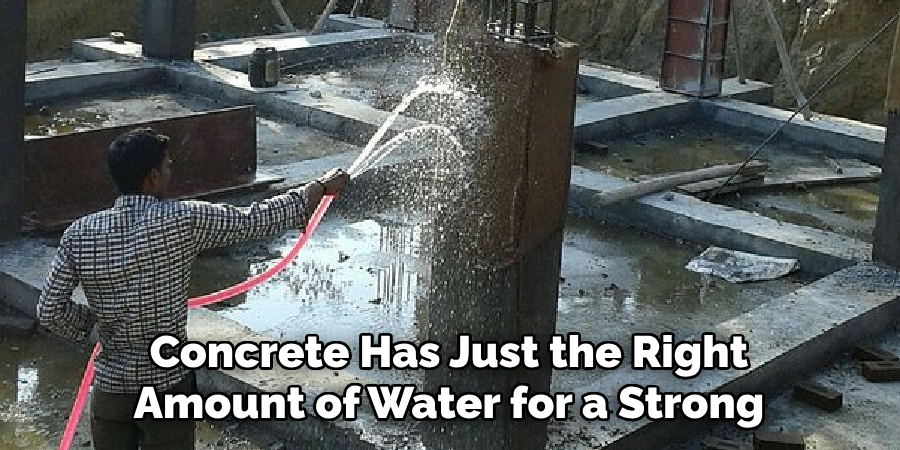Are you a homeowner trying to figure out how to tell if concrete is too wet? You aren’t alone! Many people struggle with the challenge of determining how much water is enough when mixing and pouring fresh concrete. It can be difficult to know exactly the right amount of water needed since overly wet or dry mixes can lead to insufficient results.

Don’t worry—we’ve got you covered on this essential topic, providing all the information necessary to help you identify whether or not your concrete mix is too wet before it sets.
Keep reading for our complete guide on understanding what causes excess moisture in cement and advice on what steps need to be taken should it turn out that your fresh pour has become oversaturated.
9 Best Ways on How to Tell if Concrete is Too Wet
1. Use the Slump Test:
The most commonly used method to determine if your concrete is too wet is by performing a slump test. This involves filling a standardized metal cone-shaped mold with freshly mixed concrete, carefully lifting it, and measuring how much it slumps or settles.
If it falls more than four inches, then this indicates that the mix has excessive water content. A slump of four inches or less is generally considered the ideal range.
2. Check for Excessive Bleeding:

Bleeding occurs when water rises to the surface of freshly poured concrete, and too much bleeding can be a sign that your mix is too wet. To check for this, observe if there are any pools of water on top of your pour, as well as if the water is still present after a few minutes.
If so, then it’s likely that your concrete mix has been oversaturated with water. This can lead to weakened concrete and increase the risk of cracking.
3. Use a Moisture Meter:
For more precise measurements, consider using a moisture meter specifically designed for concrete. These tools use electrical resistance to measure the amount of water in the mix and can provide accurate readings within seconds.
However, it’s important to note that moisture meters may not be readily available for homeowners and could be more expensive than other methods.
4. Look for Signs of Shrinkage:
Concrete that is too wet can shrink more during the drying process, causing cracks and uneven surfaces. Inspect your pour for any signs of shrinkage, such as large cracks or curling edges.
If you notice these issues, it may be a sign that your mix has an excessive amount of water which could lead to further problems down the line.
5. Pay Attention to Surface Texture:

A concrete mix with too much water will often have a smooth, shiny surface compared to a properly mixed batch that should have a rougher texture. The shine is caused by excess moisture rising to the top during the pouring process. This can result in a weaker and less durable finish, especially in outdoor applications.
6. Examine the Formwork:
Before pouring your concrete, check the formwork or molds for any signs of water seeping through. If you notice that water is escaping from the bottom, it could be an indication that your mix is too wet. It is important to address this issue before proceeding with the pour as it can lead to uneven curing and cause structural issues.
7. Use a Penetration Resistance Test:
Similar to moisture meters, a penetration resistance test uses electrical resistance to measure the amount of water in concrete. However, instead of measuring the overall moisture content, this test focuses on how easily a probe can penetrate the concrete surface. A lower resistance indicates that the mix is too wet.
8. Observe the Color:
While it may not be as accurate as other methods, observing the color of your concrete can also provide clues about its moisture content.
A mix with too much water will often have a lighter color compared to a properly mixed batch which should have a darker, more uniform appearance. Keep in mind that this method is not as reliable and should be used in conjunction with other techniques.
9. Consult a Professional:
If you are still unsure about the moisture content of your concrete, it’s always best to consult a professional contractor or engineer for their expert opinion.
They have the knowledge and experience to properly assess your pour and determine if any corrective action needs to be taken before it sets. This can save you time, money, and potential headaches in the long run.
Following these tips can help you determine if your concrete mix is too wet and take necessary precautions to prevent potential problems.
Remember, it’s always better to err on the side of caution and ensure that your concrete has just the right amount of water for a strong and durable finish. Keep this guide handy for future reference, and happy pouring!

So next time you need to pour fresh concrete, you’ll be well-equipped to gauge its moisture level and make adjustments as needed. So don’t wait, get started on your next project with confidence knowing you can properly identify if your concrete mix is too wet!
Additional Tips and Tricks to Tell if Concrete is Too Wet
1. If you are using a moisture meter to measure the water content in concrete, make sure to calibrate it before use. This will ensure accurate readings and prevent false results.
2. Use a plastic sheet or polyethylene cover to create an airtight seal over the concrete surface. After 24 hours, check for condensation forming on the underside of the plastic sheet. If there is condensation present, then the concrete is still too wet.
3. Another way to check for moisture in concrete is by performing a plastic sheet test. Simply place a small piece of plastic sheet on the surface of the concrete and tape down the edges. After 24 hours, check for any dark or damp spots under the plastic. If there are any, this indicates that the concrete is still too wet.
4. You can also try the hand test, where you place your hand on the surface of the concrete and press down firmly. If your hand comes away with moisture or a dark imprint, then the concrete is still too wet.
5. To speed up the drying process, you can use fans or heaters to circulate air over the surface of the concrete. Just make sure not to overheat the concrete, as this can lead to cracking or other damage.
6. Keep in mind that environmental factors such as temperature and humidity can also affect the drying time of concrete. In colder temperatures or high humidity, it may take longer for the concrete to dry.
7. It’s always better to err on the side of caution and wait a little longer for the concrete to dry before proceeding with any further construction or finishing work.
8. If you’re unsure about the moisture level of your concrete, it’s always best to consult with a professional contractor or engineer who has experience working with concrete.
9. Remember that proper curing is crucial for the strength and durability of concrete, so it’s important not to rush the drying process.
10. Once the concrete is dry, you can perform a final moisture test by taping a small piece of plastic sheet on the surface and leaving it for 24 hours. If there is no condensation or dampness under the plastic, then the concrete is ready for further work.
Following these additional tips and tricks can help you accurately determine if the concrete is too wet. It’s important to be patient and thorough when checking the moisture level, as rushing or neglecting this step can lead to problems with the strength and longevity of your concrete structure. Always consult a professional if you have any concerns or doubts about the drying process. So go ahead and use these techniques to ensure that your concrete is perfectly cured and ready for use.

Frequently Asked Questions
What is Concrete?
Concrete is a composite material made up of cement, water, and aggregates (sand, gravel o, crushed stone). It is widely used in construction due to its strength, durability, and versatility. It is one of the most widely used building materials in the world and can be found in almost every structure, from buildings to bridges to highways.
How is Concrete Made?
Concrete is made by mixing cement, water, and aggregates. The ratio of these ingredients can vary depending on the desired strength and purpose of the concrete. The chemical reaction between the cement and water causes it to harden and bind the aggregates together, forming a solid mass.
Can Concrete Be Too Wet?
Yes, concrete can be too wet. The ideal consistency for concrete is a thick, paste-like consistency that can be molded and shaped. If the concrete is too wet, it will have a soupy texture and will not hold its shape or strength properly. This can lead to cracks, low strength, and other issues in the final product.
Conclusion
All in all, knowing how to tell if concrete is too wet is an important factor in ensuring the quality and strength of any concrete structure. It is essential to closely monitor the consistency of the concrete during mixing and pouring to ensure it meets the necessary standards.
By following proper guidelines and techniques, you can help prevent potential issues with wet or poorly mixed concrete, ultimately saving time and resources in the long run. Remember, when it comes to concrete, the key is to find that perfect balance between too wet and too dry. So, always strive for that ideal consistency!
